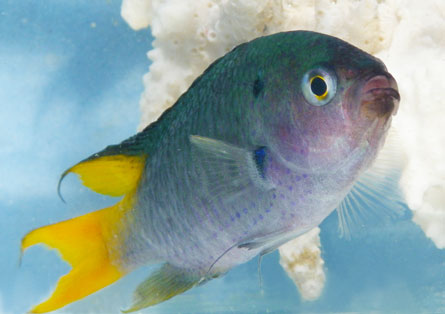A new study may explain how rising carbon dioxide concentrations — and the ocean acidification they induce — can cause topsy-turvy changes in the behavior of fish. Like a flipped switch, the normal response of nerve cells can reverse as acidifying seawater perturbs how a fish regulates acids and bases in its body, including the brain.

“This could be a big deal,” says neurobiologist Andrew Dittman of the National Oceanic and Atmospheric Administration’s Northwest Fisheries Science Center in Seattle. Dittman, who was not affiliated with the study, says the new findings could go a long way toward explaining curious sensory changes observed in fish exposed to acidifying waters. The scary scent of predators, for example, can suddenly become alluring.
For the new study, published online January 15 in Nature Climate Change, Göran Nilsson of the University of Oslo and his colleagues homed in on brain chemistry.
The idea emerged after Philip Munday of James Cook University in Townsville, Australia, told Nilsson of behavioral quirks his laboratory fish were exhibiting in a high–carbon dioxide environment — conditions exemplifying ocean waters a half-century or more from now. Nilsson, a neurophysiologist, speculated that a connection between nerves and chemistry might be involved. “It was very much an ‘Aha’ moment,” Munday says.
Once excited, nerve cells need a chemical to calm them down. A compound known as GABA does this by unlocking a gate on the cells’ outer membrane, allowing ions of chloride and bicarbonate to enter and quiet the cell. Nilsson speculated that when a fish’s body attempts to maintain chemical balance in the face of rising ocean acidification, chloride and bicarbonate concentrations could become higher inside nerve cells than outside them.
Later, when GABA gates opened, chloride and bicarbonate would then rush out of the cell instead of into it. That would excite the cell instead of calming it, essentially reversing the nerve’s response to a stimulus.
To test the idea, Nilsson’s group briefly bathed some hatchling reef fish in a chemical that deactivates the GABA gateway. Among clownfish raised in a high–carbon dioxide environment, a predator’s scent in the water — normally repellent — proved an attractant. Until, that is, the researchers immersed these fish for 30 minutes in water heavily spiked with gabazine, which locks the GABA gate closed. When the fish then reentered carbon dioxide–enriched water, a predator’s scent proved repellent, the scientists found.
Fish normally show a preference for turning one direction versus another, the piscine equivalent of a human’s left- or right-handedness. In a second experiment, this time using Australian damselfish, Nilsson’s group showed that fish in a high–carbon dioxide environment exhibited no turning preference. After a brief bout in gabazine-laced water, however, the fish suddenly demonstrated a marked preference for turning in one direction or the other.
“These are really fascinating results,” says Dittman. But scientists need to confirm the idea by looking for actual changes in the cells, he says, not just reversals of sensory-based behavioral changes.
That’s hard to do with teensy, baby fish, Nilsson says, which is why he and Munday are now extending their new studies into adults.






